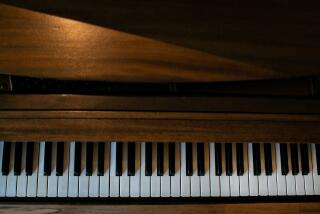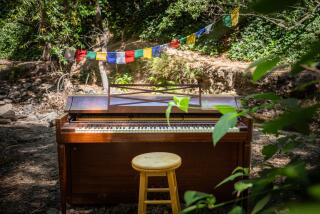A Pre-Victorian Piano Strikes a Historical Chord
- Share via
WALDORF, Md. — The lovely old piano sounds as frail and plaintive and haunting as an aging diva when Frank Owens taps out a scale on the yellowed ivory keys.
“To me, it sounds like it’s coming to life,” he says, “almost like it’s taking its first breath.”
Owens has what amounts to a private museum in his home near Waldorf, southeast of Washington, D.C. He’s amassed an extraordinary collection of Civil War memorabilia and Native American artifacts. But he’d never collected a pre-Victorian musical instrument until a friend called about this old, square piano in the basement of a dead man’s estate.
What he found half-buried in a pile of junk was a piano made nearly two centuries ago by an American named Alpheus Babcock, one of the great innovators in the history of the piano. In 1825, Babcock invented the cast-iron frame that is used in every modern piano.
“I bent over and looked at the front, and I saw it had keys. It sparked something in me. I said, that’s what I want,” says Owens, 52.
A private investigator and archeologist, he is a diligent and tenacious researcher who has thoroughly explored and mapped the escape route of John Wilkes Booth through Maryland’s Zekiah Swamp after the Lincoln assassination.
He’s traced the extraordinary odyssey of his piano from Philadelphia into the Gulf of Mexico to New Orleans, up the Mississippi and Ohio rivers by steamboat and then an additional 200 miles on a flatboat up the Wabash to Lafayette, Ind., and overland to Logansport, Ind.--and then back east again, perhaps 150 years later.
The piano evokes a kind of romantic lyricism in him.
“I can imagine all the family on a summer night, or a winter night, and all they would hear is echoes from this piano, and the family would be gathered around, and all I could envision was these people from that period just listening, all by the glow of candlelight,” he says.
“And off in the distance, if you were to approach this beautiful home, all you would see is the glow of the candlelight flickering, and you’d hear this wonderful music and laughter coming from inside this house.”
The piano stands among the cases and cabinets that contain the Civil War relics, fossils and Native American arrowheads and axes that Owens and his assistant, George Vougioukles, have unearthed locally. Next to the piano is a mummy and a papier-mache case Owens made for a United Way campaign. He’s also a sculptor who worked with Frederick Hart on sculptures that adorn the National Cathedral in Washington, D.C.
He uncovered the piano about a year ago when his curiosity took him to the home of the recently deceased William Louis Cornwell, whose estate was being sold. Nobody wanted the three pianos that remained in the Cornwell house. Owens wasn’t interested in two of them. But in a corner of the dark, musty basement he found the third covered with a tarp and debris.
“Wood scraps and years of dust were piled on top of what looked like a long box,” he says. “Inside it looked as though several generations of mice had called the inner chamber home. Nuts and nesting material were packed inside.”
He took it home and started cleaning. With a surgical probe he pulled stuff out through an opening in the soundboard--lots of peanuts, and a small pair of spectacles, a Continental Army button and a heart-shaped locket snapped in two.
Owens polished it with linseed oil and elbow grease, and the mahogany piano now glows with a dark, rich sheen.
“When I opened it, I could tell I was the first one in years to touch it,” he says. “It thrills me to touch something untouched.”
When he first lifted the top of the piano, he found inside brown and brittle fragments of a clipping from a newspaper called the Logansport Pharos for Tuesday, May 3, 1904. The research into the piano’s past began there.
The headline on the newspaper scraps says: “Piano With History ... Old Instrument Brought Here in Pioneer Days Is Unearthed ... Sent From New Orleans by Boat.”
But about one-third of the story was missing. Owens located files of the Pharos in the Logansport library in Indiana and was sent the rest of the story.
“According to the article,” Owens says, “in 1904 the piano was discovered in a basement. Ninety-seven years later, I discovered the piano in a basement.”
Engraved on a brass plate just above the keyboard is the inscription “Made by A. Babcock for John G. Klemm.” Klemm was a Philadelphia music publisher who seems also to have sold instruments.
Babcock patented the first one-piece iron piano frame in 1825. Babcock’s harp-shaped iron frame allowed for greater string tension, which produces the bigger, louder, more stable tone of the modern piano. Earlier wooden frames warped under string tension and went out of tune easily. Before Babcock’s invention, pianos were sometimes tuned in mid-concert.
Only two Babcock pianos with iron frames are known to have survived. One was featured in the Smithsonian’s Piano 300 exhibit in 2001.
Owens’ rediscovered piano has a wooden frame, which makes him think it was made before 1825. “This harp here is all hand-hewn and carved,” he says, stroking the wood under the frame. “There’s so much charm in that. I just love that. I just come down and smell it and touch it.”
Carl Schoettler writes for the Baltimore Sun, a Tribune company.
More to Read
The biggest entertainment stories
Get our big stories about Hollywood, film, television, music, arts, culture and more right in your inbox as soon as they publish.
You may occasionally receive promotional content from the Los Angeles Times.










